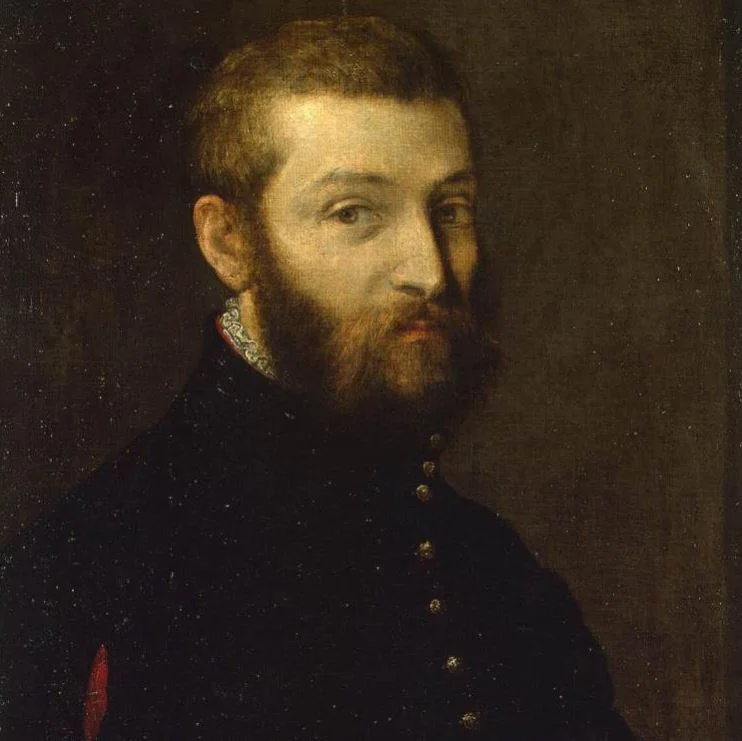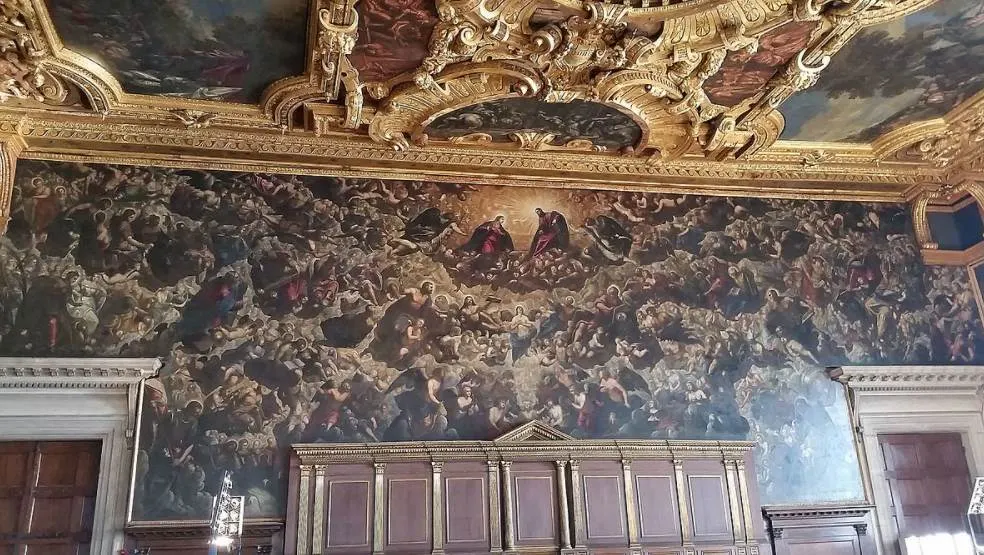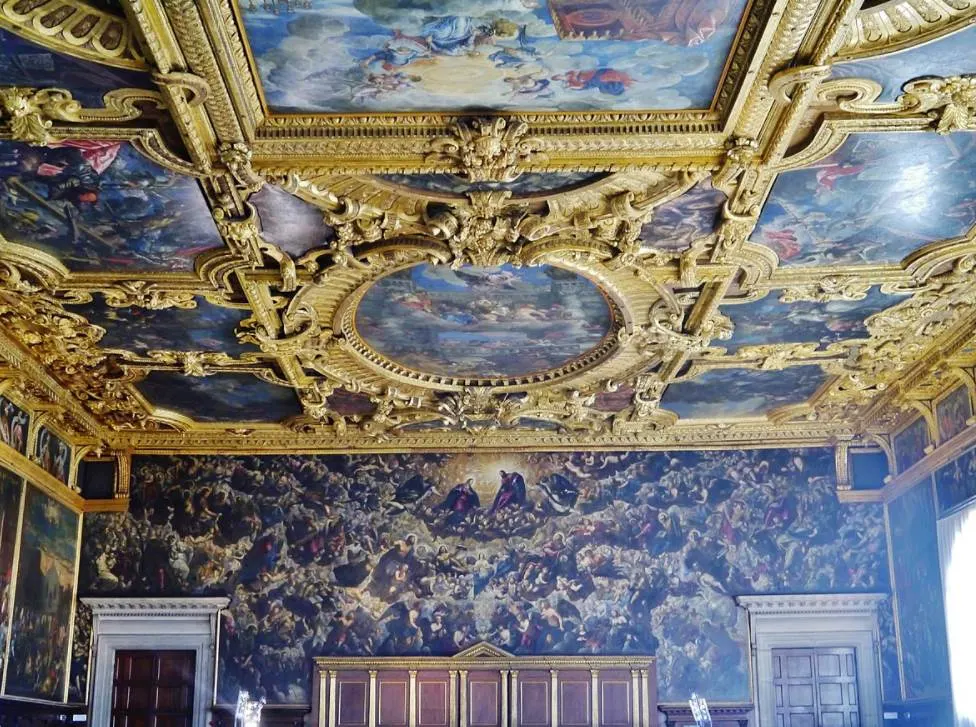One of the greatest rooms in the world can be found at the Doge’s Palace in Venice. It’s decorated with a large number of paintings that make you stand in awe.
One of these paintings was produced by one of the greatest Venetian Mannerist artists (Late Renaissance) of the 16th century who didn’t shy away to create monumental works of art.
Let’s take a closer look at some of the most interesting facts about the “Apotheosis of Venice” by Paolo Veronese (1528-1588), one of the most remarkable works in his oeuvre for several reasons.
1. It was painted in the final years of the artist’s life
Paolo Veronese was an artist who lived and worked in the Republic of Venice and moved to the city of Venice in the year 1553. He quickly made his name in the city as a supreme colorist, virtually unmatched by anyone before him.
His specialty was to create immense historical and allegorical paintings, often commissioned to decorate entire walls of large rooms. He didn’t have any problems getting commissions as new churches and monasteries popped out frequently in Venice during the 16th century.
By the time he was commissioned to paint the Apotheosis of Venice in the 1580s, a large allegorical painting with a political message, he was in his late 50s. By then, his family workshop had expanded so much that he most definitely wasn’t the only one creating these large canvases.
Veronese died in Venice in 1588 just 3 years after this monumental work of art was completed in 1585.

2. It’s located in the most important chamber of the Doge’s Palace
The painting was commissioned to decorate the ceiling of the Chamber of the Great Council at the Doge’s Palace in Venice. This remarkable palace was originally built in the 14th century in the Venetian Gothic architectural style and was continuously expanded over the centuries.
The main reason why this painting was commissioned was because of an intense fire in 1577. This fire damaged multiple rooms of the palace, including the “Sala del Maggior Consiglio” and all the major works of art that decorated it at that time.

Some of the lost works were paintings by Titian, Bellini, and an enormous fresco by 14th-century painter Guariento, to name just a few of the treasures that were lost to history.
This room was completely reconstructed shortly after between 1577 and 1580 and the local government started to commission new artworks to decorate the room, including the Apotheosis of Venice by Paolo Veronese.

3. It depicts the crowning of the personification of Venice
The painting is a huge allegory as it depicts the personification of Venice who is being crowned by flying victories. The grandeur of the scene is emphasized by the royally-dressed Venice.
As Venice drifts onto a cloud in between elaborately decorated columns and just above a triumphal arch, the residents of Venice are looking at the scene from a balcony below. The twin towers of the Arsenal of Venice can be seen right next to Venice herself as well.

4. It’s one of the 35 paintings the ceiling of this huge room
If you’re prone to develop a sudden case of the Stendhal Syndrome, an overwhelming feeling caused by an overload of beautiful art, then you might not want to enter the Chamber of the Great Council at the Doge’s Palace in Venice.
This room is not only 53 meters (173 feet) long and 25 meters (82 feet) wide, making it one of the largest rooms inside a building in Europe, but is also completely plastered with remarkable works of art.
The ceiling alone, the location of the Apotheosis of Venice, is decorated with 35 paintings. The sidewalls feature 6 immense paintings depicting various wars that occurred in the history of the Republic of Venice.
The frieze right below the ceiling is a series of 76 artworks that depict the first 76 Doges, the highest officials of the Republic of Venice.

5. The largest canvas painting in the world is located here as well
The members of the Great Council of Venice were happy with the output of Paolo Veronese. This is emphasized by the fact that Veronese, together with Francesco Bassano, was chosen to complete a huge painting to decorate the main wall of the room.
Unfortunately, Veronese died before he could complete the work and this painting was completed by Jacopo “Il Furioso” Robusti, also known as Tintoretto, a man known for the speed in which he could produce huge paintings.
This painting is called “Il Paradiso” and is considered to be the largest oil on canvas painting in the world with dimensions of 9.1 x 22.6 meters (29.9 x 74.1 feet).

6. How big is the Apotheosis of Venice?
To stand out inside this remarkable room at the Doge’s Palace, the painting glorifying Venice had to be painted at a monumental scale as well.
Paolo Veronese was definitely up for this job as some of his most famous paintings are immense works of art as well. This is especially the case for his banquet scenes such as “The Wedding at Cana” (1562-1563) and “The Feast in the House of Levi” (1573).
The Apotheosis of Venice has dimensions of 904 x 579 centimeters (355 x 227 inches).
7. Where is the Apotheosis of Venice located?
WIth 35 paintings decorating the ceiling of the Chamber of the Great Council of the Doges Palace in Venice, you might not have an easy time locating this remarkable work of art.
Luckily, it’s pretty easy to find because it’s the painting closest to “Il Paradiso,” the huge work decorating the wall of the room.

8. The painting was intended to be a political statement
The painting was intended to represent the glory of Venice. At the feet of the personification of Venice, we can see personifications of the values she represents. These are allegorical personifications of peace, abundance, fame, happiness, honor, security, and freedom.
In the lower section of the painting, we can see soldiers riding horses, a reflection of the military power of the Republic of Venice.
Yes, the idea of this remarkable work of art was to use it as a political statement of not only everybody who entered the room, but also the members of the Great Council themselves as they were intended to honor the value of the Republic while making important decisions.

